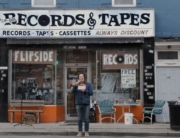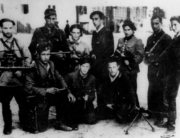
Teacher Gyongyi Mago (Photo: Gabor Kalman)
Directed by Gabor Kalman
Produced by Kalman & Gabor Garami
English & Hungarian with English subtitles
USA/Hungary. 103 min. Not rated
There Was Once … starts out like a teacher’s history lesson about a vanished past, but turns into a detective story as memories collide, old photographs and documents link to living witnesses, and, worse, a nightmare starts to repeat.
Catholic high school teacher Gyongyi Mago was just looking for a topic for her dissertation on local history when she started researching the history of the Jews in her hometown of Kalocsa, Hungary, a community that no one seemed to know had ever existed. She had to search her archbishop’s library to find documents going back to the 1770s that tracked the church’s first granting of permission for Jews to come through her town, establish businesses, settle down, and build a synagogue. Its bricks were donated by the archbishop, indicating a peaceful co-existence. When Mago finds a plaque at the town library noting that it was once a synagogue and that “393 of the 511 members of the congregation were victims of Fascism,” she starts asking questions about the 20th century, and participates in the annual March of the Living in Poland to learn about Auschwitz.
She returns to interview elderly residents, asking if they remember when Jews lived in their town. They reminisce about honest tradesmen, regular customers, schoolmates, and neighbors. But Mago also finds the town’s “Jaross List” of the Jewish residents to be rounded up in 1944 for extermination, produced by local officials under the direction of the collaborationist Interior Minister Andor Jaross. She cross-references the names on a crumbling memorial tablet that had been placed in the Budapest Jewish cemetery by survivors, and searches the Internet for those to interview. She finds the director Gabor Kalman, who was nine years old when his name was put on that list with his family, now returning to Hungary as a Fulbright Scholar.
One by one, Mago builds trust with other survivors and their descendants (she even finds the last Jew born in her town), and they spread the word of her project in the United States, Canada, and Israel. (They now all have names devoid of Hungarian identification.) She matches them to the youthful faces in many photographs, including a primary class portrait that is repeatedly highlighted. They have a very different, bitter story to tell of Jewish life in Hungary under the rise of fascism, the German occupation, and then the postwar difficulties under the Communists for those who returned. The survivors detail the March day, two weeks after the Germans arrived, when Jews were suddenly ordered into a ghetto. (Lukas Pribyl’s Forgotten Transports quartet of films is one of the few other documentaries to describe ghettoization outside big cities.) Inside cellars, Mago finds evidence of interior doors where neighbors could visit secretly. Even more vividly, the survivors describe the round-up three months later and the march through town to the train station, with the mixed reactions from their gaping neighbors. (The residents’ memories of offers of some assistance are supported by a few survivors, but the Jews recall that their parents mostly did not trust their neighbors during the terrors of those awful days.)
Unusually, particularly in comparison to Michael Verhoeven’s exploration of German amnesia in the satire of a student’s similar research in The Nasty Girl (1990) and in his documentary Human Failure (2008), Mago pushes further to make sure her town will not again forget, organizing a commemorative service for the 65th anniversary of the expulsion to concentration and labor camps, and inviting the survivors and their families, along with town and church officials. Even as the former primary school classmates happily reunite to look for their former houses and play areas, the neo-Nazi party that received 17 percent of the vote in recent Hungarian elections holds a noisy rally just a few blocks away. Mago weeps at how they have stirred up the old anti-Semitism. (She recently received the Medal of Valor by the Museum of Tolerance and the Simon Wiesenthal Center for her efforts.) Her daughter is touched that many of the survivors, despite everything, still consider themselves Hungarians. After the closing credits, she is seen starting her own career as a teacher, who will carry on her mother’s lessons, as, hopefully, will viewers of this insightful film.






Leave A Comment